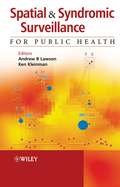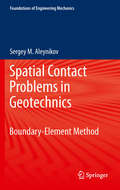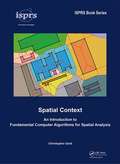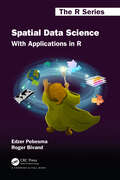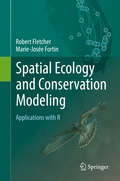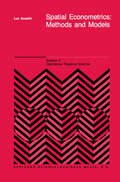- Table View
- List View
Spatial and Spatio-temporal Bayesian Models with R - INLA
by Marta Blangiardo Michela CamelettiSpatial and Spatio-Temporal Bayesian Models with R-INLA provides a much needed, practically oriented & innovative presentation of the combination of Bayesian methodology and spatial statistics. The authors combine an introduction to Bayesian theory and methodology with a focus on the spatial and spatio-temporal models used within the Bayesian framework and a series of practical examples which allow the reader to link the statistical theory presented to real data problems. The numerous examples from the fields of epidemiology, biostatistics and social science all are coded in the R package R-INLA, which has proven to be a valid alternative to the commonly used Markov Chain Monte Carlo simulations
Spatial and Spatio-Temporal Geostatistical Modeling and Kriging: Individual (Wiley Series in Probability and Statistics #998)
by José-María Montero Gema Fernández-Avilés Jorge MateuStatistical Methods for Spatial and Spatio-Temporal Data Analysis provides a complete range of spatio-temporal covariance functions and discusses ways of constructing them. This book is a unified approach to modeling spatial and spatio-temporal data together with significant developments in statistical methodology with applications in R. This book includes: Methods for selecting valid covariance functions from the empirical counterparts that overcome the existing limitations of the traditional methods. The most innovative developments in the different steps of the kriging process. An up-to-date account of strategies for dealing with data evolving in space and time. An accompanying website featuring R code and examples
Spatial and Spatio-Temporal Geostatistical Modeling and Kriging (Wiley Series in Probability and Statistics)
by José-María Montero Gema Fernández-Avilés Jorge MateuStatistical Methods for Spatial and Spatio-Temporal Data Analysis provides a complete range of spatio-temporal covariance functions and discusses ways of constructing them. This book is a unified approach to modeling spatial and spatio-temporal data together with significant developments in statistical methodology with applications in R. This book includes: Methods for selecting valid covariance functions from the empirical counterparts that overcome the existing limitations of the traditional methods. The most innovative developments in the different steps of the kriging process. An up-to-date account of strategies for dealing with data evolving in space and time. An accompanying website featuring R code and examples
Spatial and Syndromic Surveillance for Public Health
by Andrew B. Lawson Ken KleinmanFollowing the events of 9/11 and in the current world climate, there is increasing concern of the impact of potential bioterrorism attacks. Spatial surveillance systems are used to detect changes in public health data, and alert us to possible outbreaks of disease, either from natural resources or from bioterrorism attacks. Statistical methods play a key role in spatial surveillance, as they are used to identify changes in data, and build models of that data in order to make predictions about future activity. This book is the first to provide an overview of all the current key methods in spatial surveillance, and present them in an accessible form, suitable for the public health professional. It features an abundance of examples using real data, highlighting the practical application of the methodology. It is edited and authored by leading researchers and practitioners in spatial surveillance methods. Provides an overview of the current key methods in spatial surveillance of public health data. Includes coverage of both single and multiple disease surveillance. Covers all of the key topics, including syndromic surveillance, spatial cluster detection, and Bayesian data mining.
Spatial Autocorrelation and Spatial Filtering: Gaining Understanding Through Theory and Scientific Visualization (Advances in Spatial Science)
by Daniel A. GriffithScientific visualization may be defined as the transformation of numerical scientific data into informative graphical displays. The text introduces a nonverbal model to subdisciplines that until now has mostly employed mathematical or verbal-conceptual models. The focus is on how scientific visualization can help revolutionize the manner in which the tendencies for (dis)similar numerical values to cluster together in location on a map are explored and analyzed. In doing so, the concept known as spatial autocorrelation - which characterizes these tendencies - is further demystified.
Spatial Behavior in Haredi Jewish Communities in Great Britain (The Urban Book Series)
by Shlomit Flint AsheryThis book focuses on the strict orthodox Jewish (Haredi) community, which comprises many sects whose communal identity plays a central role in everyday life and spatial organization. The research reveals and analyses powerful mechanisms of residential segregation acting at the apartment-, building- and near-neighbourhood levels. Identifying the main engines of spontaneous and organised neighbourhood change and evaluating the difficulties of liberalism dealing with non-autonomous individuals in the housing market sheds light on similar processes occurring in other city centres with diverse population groups. Highlighting the impact of various organisational levels on the spatial structure of the urban enclave, the book focuses on the internal dynamics of ethno-religious enclaves that emerge from three levels of action: (1) individuals' relationships with their own and other groups; (2) the community leadership's powers within the group and in respect of other groups; and (3) government directives and tools (e.g planning). The study examines how different levels of communal organisation are reflected in the residential patterns of four British communities: the Litvish communities of Golders Green and Gateshead, and the Hassidic communities of Stamford Hill and Canvey Island.
Spatial Branching Processes, Random Snakes and Partial Differential Equations (Lectures in Mathematics. ETH Zürich)
by Jean-Francois Le GallThis book introduces several remarkable new probabilistic objects that combine spatial motion with a continuous branching phenomenon and are closely related to certain semilinear partial differential equations (PDE). The Brownian snake approach is used to give a powerful representation of superprocesses and also to investigate connections between superprocesses and PDEs. These are notable because almost every important probabilistic question corresponds to a significant analytic problem.
Spatial Complexity: Theory, Mathematical Methods and Applications
by Fivos PapadimitriouThis book delivers stimulating input for a broad range of researchers, from geographers and ecologists to psychologists interested in spatial perception and physicists researching in complex systems. How can one decide whether one surface or spatial object is more complex than another? What does it require to measure the spatial complexity of small maps, and why does this matter for nature, science and technology? Drawing from algorithmics, geometry, topology, probability and informatics, and with examples from everyday life, the reader is invited to cross the borders into the bewildering realm of spatial complexity, as it emerges from the study of geographic maps, landscapes, surfaces, knots, 3D and 4D objects. The mathematical and cartographic experiments described in this book lead to hypotheses and enigmas with ramifications in aesthetics and epistemology.
Spatial Contact Problems in Geotechnics: Boundary-Element Method (Foundations of Engineering Mechanics)
by Sergey AleynikovThis book presents a systematic approach to numerical solution for a wide range of spatial contact problems of geotechnics. On the basis of the boundary element method new techniques and effective computing algorithms are considered. Special attention is given to the formulation and analysis of the spatial contact models for elastic bases. Besides the classical schemes of contact deformation, new contact models are discussed for spatially nonhomogeneous and nonlinearly elastic media properly describing soil properties.
Spatial Context: An Introduction to Fundamental Computer Algorithms for Spatial Analysis (ISPRS Book Series)
by Christopher GoldMany disciplines are concerned with manipulating geometric (or spatial) objects in the computer – such as geology, cartography, computer aided design (CAD), etc. – and each of these have developed their own data structures and techniques, often independently. Nevertheless, in many cases the object types and the spatial queries are similar, and this book attempts to find a common theme.
Spatial Context: An Introduction to Fundamental Computer Algorithms for Spatial Analysis (ISPRS Book Series)
by Christopher GoldMany disciplines are concerned with manipulating geometric (or spatial) objects in the computer – such as geology, cartography, computer aided design (CAD), etc. – and each of these have developed their own data structures and techniques, often independently. Nevertheless, in many cases the object types and the spatial queries are similar, and this book attempts to find a common theme.
Spatial Data Analysis: Models, Methods and Techniques (SpringerBriefs in Regional Science)
by Manfred M. Fischer Jinfeng WangThe availability of spatial databases and widespread use of geographic information systems has stimulated increasing interest in the analysis and modelling of spatial data. Spatial data analysis focuses on detecting patterns, and on exploring and modelling relationships between them in order to understand the processes responsible for their emergence. In this way, the role of space is emphasised , and our understanding of the working and representation of space, spatial patterns, and processes is enhanced. In applied research, the recognition of the spatial dimension often yields different and more meaningful results and helps to avoid erroneous conclusions. This book aims to provide an introduction into spatial data analysis to graduates interested in applied statistical research. The text has been structured from a data-driven rather than a theory-based perspective, and focuses on those models, methods and techniques which are both accessible and of practical use for graduate students. Exploratory techniques as well as more formal model-based approaches are presented, and both area data and origin-destination flow data are considered.
Spatial Data Configuration in Statistical Analysis of Regional Economic and Related Problems (Advanced Studies in Theoretical and Applied Econometrics #14)
by Giuseppe ArbiaFigure 1. 1. Map of Great Britain at two different scale levels. (a) Counties, (b)Regions. '-. " Figure 1. 2. Two alternative aggregations of the Italian provincie in 32 larger areas 4 CHAPTER 1 d . , b) Figure 1. 3 Percentage of votes of the Communist Party in the 1987 Italian political elections (a) and percentage of population over 75 years (b) in 1981 Italian Census in 32 polling districts. The polling districts with values above the average are shaded. Figure 1. 4: First order neighbours (a) and second order neighbours (b) of a reference area. INTRODUCTION 5 While there are several other problems relating to the analysis of areal data, the problem of estimating a spatial correlO!J'am merits special attention. The concept of the correlogram has been borrowed in the spatial literature from the time series analysis. Figure l. 4. a shows the first-order neighbours of a reference area, while Figure 1. 4. b displays the second-order neighbours of the same area. Higher-order neighbours can be defined in a similar fashion. While it is clear that the dependence is strongest between immediate neighbouring areas a certain degree of dependence may be present among higher-order neighbours. This has been shown to be an alternative way of look ing at the sca le problem (Cliff and Ord, 1981, p. l 23). However, unlike the case of a time series where each observation depends only on past observations, here dependence extends in all directions.
Spatial Data Science: With Applications in R (Chapman & Hall/CRC The R Series)
by Edzer Pebesma Roger BivandSpatial Data Science introduces fundamental aspects of spatial data that every data scientist should know before they start working with spatial data. These aspects include how geometries are represented, coordinate reference systems (projections, datums), the fact that the Earth is round and its consequences for analysis, and how attributes of geometries can relate to geometries. In the second part of the book, these concepts are illustrated with data science examples using the R language. In the third part, statistical modelling approaches are demonstrated using real world data examples. After reading this book, the reader will be well equipped to avoid a number of major spatial data analysis errors. The book gives a detailed explanation of the core spatial software packages for R: sf for simple feature access, and stars for raster and vector data cubes – array data with spatial and temporal dimensions. It also shows how geometrical operations change when going from a flat space to the surface of a sphere, which is what sf and stars use when coordinates are not projected (degrees longitude/latitude). Separate chapters detail a variety of plotting approaches for spatial maps using R, and different ways of handling very large vector or raster (imagery) datasets, locally, in databases, or in the cloud. The data used and all code examples are freely available online from https://r-spatial.org/book/. The solutions to the exercises can be found here: https://edzer.github.io/sdsr_exercises/.
Spatial Data Science: With Applications in R (Chapman & Hall/CRC The R Series)
by Edzer Pebesma Roger BivandSpatial Data Science introduces fundamental aspects of spatial data that every data scientist should know before they start working with spatial data. These aspects include how geometries are represented, coordinate reference systems (projections, datums), the fact that the Earth is round and its consequences for analysis, and how attributes of geometries can relate to geometries. In the second part of the book, these concepts are illustrated with data science examples using the R language. In the third part, statistical modelling approaches are demonstrated using real world data examples. After reading this book, the reader will be well equipped to avoid a number of major spatial data analysis errors. The book gives a detailed explanation of the core spatial software packages for R: sf for simple feature access, and stars for raster and vector data cubes – array data with spatial and temporal dimensions. It also shows how geometrical operations change when going from a flat space to the surface of a sphere, which is what sf and stars use when coordinates are not projected (degrees longitude/latitude). Separate chapters detail a variety of plotting approaches for spatial maps using R, and different ways of handling very large vector or raster (imagery) datasets, locally, in databases, or in the cloud. The data used and all code examples are freely available online from https://r-spatial.org/book/. The solutions to the exercises can be found here: https://edzer.github.io/sdsr_exercises/.
The Spatial Distribution of Microbes in the Environment
by Rima Franklin Aaron MillsThis volume highlights recent advances that have contributed to our understanding of spatial patterns and scale issues in microbial ecology. The book brings together research conducted at a range of spatial scales (from µm to km) and in a variety of different types of environments. These topics are addressed in a quantitative manner, and a primer on statistical methods is included. In soil ecosystems, both bacteria and fungi are discussed.
Spatial Dynamics and Pattern Formation in Biological Populations
by Ranjit Kumar Upadhyay Satteluri R. IyengarThe book provides an introduction to deterministic (and some stochastic) modeling of spatiotemporal phenomena in ecology, epidemiology, and neural systems. A survey of the classical models in the fields with up to date applications is given. The book begins with detailed description of how spatial dynamics/diffusive processes influence the dynamics of biological populations. These processes play a key role in understanding the outbreak and spread of pandemics which help us in designing the control strategies from the public health perspective. A brief discussion on the functional mechanism of the brain (single neuron models and network level) with classical models of neuronal dynamics in space and time is given. Relevant phenomena and existing modeling approaches in ecology, epidemiology and neuroscience are introduced, which provide examples of pattern formation in these models. The analysis of patterns enables us to study the dynamics of macroscopic and microscopic behaviour of underlying systems and travelling wave type patterns observed in dispersive systems. Moving on to virus dynamics, authors present a detailed analysis of different types models of infectious diseases including two models for influenza, five models for Ebola virus and seven models for Zika virus with diffusion and time delay. A Chapter is devoted for the study of Brain Dynamics (Neural systems in space and time). Significant advances made in modeling the reaction-diffusion systems are presented and spatiotemporal patterning in the systems is reviewed. Development of appropriate mathematical models and detailed analysis (such as linear stability, weakly nonlinear analysis, bifurcation analysis, control theory, numerical simulation) are presented. Key Features Covers the fundamental concepts and mathematical skills required to analyse reaction-diffusion models for biological populations. Concepts are introduced in such a way that readers with a basic knowledge of differential equations and numerical methods can understand the analysis. The results are also illustrated with figures. Focuses on mathematical modeling and numerical simulations using basic conceptual and classic models of population dynamics, Virus and Brain dynamics. Covers wide range of models using spatial and non-spatial approaches. Covers single, two and multispecies reaction-diffusion models from ecology and models from bio-chemistry. Models are analysed for stability of equilibrium points, Turing instability, Hopf bifurcation and pattern formations. Uses Mathematica for problem solving and MATLAB for pattern formations. Contains solved Examples and Problems in Exercises. The Book is suitable for advanced undergraduate, graduate and research students. For those who are working in the above areas, it provides information from most of the recent works. The text presents all the fundamental concepts and mathematical skills needed to build models and perform analyses.
Spatial Dynamics and Pattern Formation in Biological Populations
by Ranjit Kumar Upadhyay Satteluri R. IyengarThe book provides an introduction to deterministic (and some stochastic) modeling of spatiotemporal phenomena in ecology, epidemiology, and neural systems. A survey of the classical models in the fields with up to date applications is given. The book begins with detailed description of how spatial dynamics/diffusive processes influence the dynamics of biological populations. These processes play a key role in understanding the outbreak and spread of pandemics which help us in designing the control strategies from the public health perspective. A brief discussion on the functional mechanism of the brain (single neuron models and network level) with classical models of neuronal dynamics in space and time is given. Relevant phenomena and existing modeling approaches in ecology, epidemiology and neuroscience are introduced, which provide examples of pattern formation in these models. The analysis of patterns enables us to study the dynamics of macroscopic and microscopic behaviour of underlying systems and travelling wave type patterns observed in dispersive systems. Moving on to virus dynamics, authors present a detailed analysis of different types models of infectious diseases including two models for influenza, five models for Ebola virus and seven models for Zika virus with diffusion and time delay. A Chapter is devoted for the study of Brain Dynamics (Neural systems in space and time). Significant advances made in modeling the reaction-diffusion systems are presented and spatiotemporal patterning in the systems is reviewed. Development of appropriate mathematical models and detailed analysis (such as linear stability, weakly nonlinear analysis, bifurcation analysis, control theory, numerical simulation) are presented. Key Features Covers the fundamental concepts and mathematical skills required to analyse reaction-diffusion models for biological populations. Concepts are introduced in such a way that readers with a basic knowledge of differential equations and numerical methods can understand the analysis. The results are also illustrated with figures. Focuses on mathematical modeling and numerical simulations using basic conceptual and classic models of population dynamics, Virus and Brain dynamics. Covers wide range of models using spatial and non-spatial approaches. Covers single, two and multispecies reaction-diffusion models from ecology and models from bio-chemistry. Models are analysed for stability of equilibrium points, Turing instability, Hopf bifurcation and pattern formations. Uses Mathematica for problem solving and MATLAB for pattern formations. Contains solved Examples and Problems in Exercises. The Book is suitable for advanced undergraduate, graduate and research students. For those who are working in the above areas, it provides information from most of the recent works. The text presents all the fundamental concepts and mathematical skills needed to build models and perform analyses.
Spatial Ecology and Conservation Modeling: Applications with R
by Robert Fletcher Marie-Josée FortinThis book provides a foundation for modern applied ecology. Much of current ecology research and conservation addresses problems across landscapes and regions, focusing on spatial patterns and processes. This book is aimed at teaching fundamental concepts and focuses on learning-by-doing through the use of examples with the software R. It is intended to provide an entry-level, easily accessible foundation for students and practitioners interested in spatial ecology and conservation.
Spatial Ecology via Reaction-Diffusion Equations (Wiley Series in Mathematical & Computational Biology)
by Robert Stephen Cantrell Chris CosnerMany ecological phenomena may be modelled using apparently random processes involving space (and possibly time). Such phenomena are classified as spatial in their nature and include all aspects of pollution. This book addresses the problem of modelling spatial effects in ecology and population dynamics using reaction-diffusion models. * Rapidly expanding area of research for biologists and applied mathematicians * Provides a unified and coherent account of methods developed to study spatial ecology via reaction-diffusion models * Provides the reader with the tools needed to construct and interpret models * Offers specific applications of both the models and the methods * Authors have played a dominant role in the field for years Essential reading for graduate students and researchers working with spatial modelling from mathematics, statistics, ecology, geography and biology.
Spatial Econometric Interaction Modelling (Advances in Spatial Science)
by Roberto Patuelli Giuseppe ArbiaThis contributed volume applies spatial and space-time econometric methods to spatial interaction modeling. The first part of the book addresses general cutting-edge methodological questions in spatial econometric interaction modeling, which concern aspects such as coefficient interpretation, constrained estimation, and scale effects. The second part deals with technical solutions to particular estimation issues, such as intraregional flows, Bayesian PPML and VAR estimation. The final part presents a number of empirical applications, ranging from interregional tourism competition and domestic trade to space-time migration modeling and residential relocation.
Spatial Econometrics: Statistical Foundations and Applications to Regional Convergence (Advances in Spatial Science)
by Giuseppe ArbiaThis book bridges the gap between economic theory and spatial econometric techniques. It is accessible to those with only a basic statistical background and no prior knowledge of spatial econometric methods. It provides a comprehensive treatment of the topic, motivating the reader with examples and analysis. The volume provides a rigorous treatment of the basic spatial linear model, and it discusses the violations of the classical regression assumptions that occur when dealing with spatial data.
Spatial Econometrics: Methods and Applications (Studies in Empirical Economics)
by Giuseppe Arbia Badi H. BaltagiSpatial Econometrics is a rapidly evolving field born from the joint efforts of economists, statisticians, econometricians and regional scientists. The book provides the reader with a broad view of the topic by including both methodological and application papers. Indeed the application papers relate to a number of diverse scientific fields ranging from hedonic models of house pricing to demography, from health care to regional economics, from the analysis of R&D spillovers to the study of retail market spatial characteristics. Particular emphasis is given to regional economic applications of spatial econometrics methods with a number of contributions specifically focused on the spatial concentration of economic activities and agglomeration, regional paths of economic growth, regional convergence of income and productivity and the evolution of regional employment. Most of the papers appearing in this book were solicited from the International Workshop on Spatial Econometrics and Statistics held in Rome (Italy) in 2006.
Spatial Econometrics: From Cross-Sectional Data to Spatial Panels (SpringerBriefs in Regional Science)
by J. Paul ElhorstThis book provides an overview of three generations of spatial econometric models: models based on cross-sectional data, static models based on spatial panels and dynamic spatial panel data models. The book not only presents different model specifications and their corresponding estimators, but also critically discusses the purposes for which these models can be used and how their results should be interpreted.
Spatial Econometrics: Methods and Models (Studies in Operational Regional Science #4)
by L. AnselinSpatial econometrics deals with spatial dependence and spatial heterogeneity, critical aspects of the data used by regional scientists. These characteristics may cause standard econometric techniques to become inappropriate. In this book, I combine several recent research results to construct a comprehensive approach to the incorporation of spatial effects in econometrics. My primary focus is to demonstrate how these spatial effects can be considered as special cases of general frameworks in standard econometrics, and to outline how they necessitate a separate set of methods and techniques, encompassed within the field of spatial econometrics. My viewpoint differs from that taken in the discussion of spatial autocorrelation in spatial statistics - e.g., most recently by Cliff and Ord (1981) and Upton and Fingleton (1985) - in that I am mostly concerned with the relevance of spatial effects on model specification, estimation and other inference, in what I caIl a model-driven approach, as opposed to a data-driven approach in spatial statistics. I attempt to combine a rigorous econometric perspective with a comprehensive treatment of methodological issues in spatial analysis.


